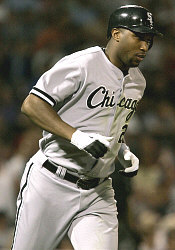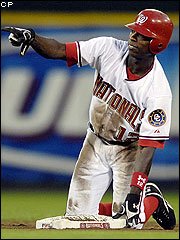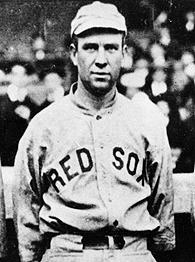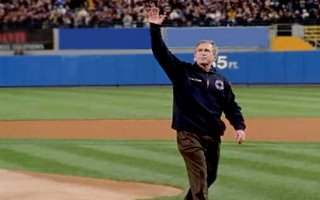
When most people are asked who the AL MVP should be, the usual answer is Derek Jeter or David Ortiz. But the most valuable player in the American League is one who is often overlooked, Jermaine Dye. The Chicago White Sox would not be in playoff contention without the clutch hitting, solid fielding, and great leadership that they have received from the veteran outfielder. While Derek Jeter and David Ortiz banter back and forth in the media, Dye has let his on field play do the talking, which is what a true MVP should do. Last season Ortiz had a legitimate gripe in not being chosen as MVP, but this season he is not the top choice. No matter how good he has been, the Red Sox have not been good enough for him to be named MVP. All his talking and whining has made it even worse for him. Jeter has put together a great season, with an excellent batting average and a great RBI total for someone hitting in the second spot in the order, but Jeter plays on a team with top hitters at every position. Dye in no way plays on a team lacking in talented hitters, with Paul Konerko and Jim Thome in front of him, but Dye's contribution to the White Sox goes far beyond Jeter's contribution to the Yankees.
Dye is a player who has had a career that has gone mostly under the radar, at least until he won the World Series MVP Award last season for the White Sox. He hit .438 with a home run and 3 RBI in the Series to help the White Sox win. The Oakland, California native was drafted by the Atlanta Braves in 1993, but was traded to the Kansas City Royals after his rookie season in 1996. Dye won the NL Rookie of the Year Award that year with the Braves. Dye broke out in 1999 as a 25 year old, hitting 27 home runs and driving in 119 runs for the Royals. Dye's best season came in 2000 when he hit 33 home runs with a .321 batting average and a .561 slugging percentage. That season made Dye to expensive for the small market Royals and he was traded to the Oakland Athletics in 2001. After three seasons in Oakland, the 31 year old right fielder signed as a free agent with the White Sox and hit 31 home runs en route to the World Series victory.
This season, Dye leads the talented White Sox in six different batting categories, which is impressive, seeing that Jim Thome and Paul Konerko are in the same lineup as he is. Dye has 41 home runs, third in the AL, is sixth in batting with a .322 average, fourth in RBI with 112, second in total bases with 313, second in slugging percentage at .637, and ninth in batting average with runners in scoring position at .353. Dye's .983 fielding percentage is fifth best among rightfielders and he has committed just 5 errors, which is also fifth best.
Just as how the question, who is the American League MVP, garners the response of Jeter or Ortiz, the response of who is the most clutch hitter in the AL draws the response of Ortiz. But not this season. This season the best clutch hitter in the AL is Dye, who has 18 home runs that have either tied the score or put the White Sox ahead. In close and late situations, Dye is hitting .306 with 5 home runs and 18 runs batted in. Dye has stepped it up against the top competition in the majors, with a .417 batting average, 7 home runs and 13 RBI against division rival Detroit, a .360 average against the New York Yankees and a .321 average with five home runs and 17 RBI against the Minnesota Twins, who have the top pitchers in the AL. Dye has also hit ninth-inning, game-tying home runs off two of the league's best closers, the Twins' Joe Nathan and the Red Sox Jonathan Papelbon.
In a win last week
against the Cleveland Indians Dye's performance proved his MVP worthiness. In the bottom of the fifth inning, Dye made a leaping catch, connecting with the wall. His catch stunned the crowd and he was left on the ground, shaken up. When he rose to his feet the crowd begin chanting, "MVP! MVP!" In the top of the sixth, Dye came up to lead off the inning and hit a home run, leaving him a single short of the cycle (he would ground out in his last at-bat), beginning the MVP chant once again.
Dye has competition, from Jeter, Ortiz, the Twin's Joe Mauer, Justin Morneau, and Johan Santana, and the Athletics' Frank Thomas. But if the Chicago White Sox make the playoffs, Dye will certainly be the top contender for the World Series. But you won't see him on ESPN telling you that, you're going to have to catch a White Sox game to see him make his case.
 What makes a meaningless late-September game at Yankee Stadium, with nothing on the line for either team, exciting? The possibility of a no-hitter. On the way to the Stadium for the game, I did not think that the game was going to be very good, especially after hearing that Derek Jeter and Alex Rodriguez would not be playing for the Yankees, and that Darell Rasner, a rookie pitcher would be making the start for New York. The crowd was intense throughout the last four innings of the game, even though the Yankees were losing 5-1 and then 7-1. The reason for the intensity was that the Yankees were being no-hit by the Baltimore Orioles' pitcher, Daniel Cabrera. The rabid Yankees fans could not bear to see their team be no-hit and while in normal circumstances, many fans would have left to beat the traffic, almost all of the 50,000 fans in attendence stayed to cheer the Yankees on, staying to see Robinson Cano break up the no-hitter with a bloop single in the 9th inning, with one out. Cabrera then sealed the one-hitter by forcing Bobby Abreu to ground into a game ending double play.
What makes a meaningless late-September game at Yankee Stadium, with nothing on the line for either team, exciting? The possibility of a no-hitter. On the way to the Stadium for the game, I did not think that the game was going to be very good, especially after hearing that Derek Jeter and Alex Rodriguez would not be playing for the Yankees, and that Darell Rasner, a rookie pitcher would be making the start for New York. The crowd was intense throughout the last four innings of the game, even though the Yankees were losing 5-1 and then 7-1. The reason for the intensity was that the Yankees were being no-hit by the Baltimore Orioles' pitcher, Daniel Cabrera. The rabid Yankees fans could not bear to see their team be no-hit and while in normal circumstances, many fans would have left to beat the traffic, almost all of the 50,000 fans in attendence stayed to cheer the Yankees on, staying to see Robinson Cano break up the no-hitter with a bloop single in the 9th inning, with one out. Cabrera then sealed the one-hitter by forcing Bobby Abreu to ground into a game ending double play.




